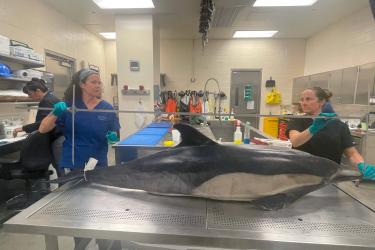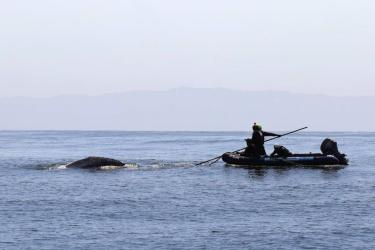Nobody wants to catch a whale. By marking their gear clearly, fishermen and other ocean users help reduce the risk of that happening. Entanglement in fishing gear presents a major threat to whales. It can drown individuals, cause long-term injuries that impact their health by limiting their ability to eat, travel and reproduce, and potentially affect population abundance. Entanglement is a pressing concern for whales off the West Coast, where documented entanglements have risen sharply during the past decade. Due to recent changes in ocean conditions there have been some increases in overlap between whales and nearshore fisheries. A better understanding of which fisheries and where the overlap is occurring is crucial.
The West Coast states and Pacific Fishery Management Council have required gear marking in commercial and recreational fisheries. These markings help NOAA Fisheries and our partners identify the origins of entanglements. However, under current requirements only about half of the reported entanglements can be linked to a specific fishery or other type of gear.
Expanding Gear Marking Requirements
The Pacific Fishery Management Council and West Coast states of Washington, Oregon, and California are considering expanding gear marking requirements. This will help us understand where and why entanglements continue, so that management actions can be directed where they are most needed. NOAA Fisheries backs their work as an important means of understanding and ideally reversing the trend.
Sometimes a passing fisherman or boater takes a picture of an entangled marine mammal and sends it to us. We need color patterns or marking systems that are easily visible and identifiable from photographs to identify recovered gear. They are essential for successful line and gear marking programs. This information would tell us the specific origins of the entanglements. It would allow us to recommend specific actions to state and federal fishery managers to help reduce the risk of future entanglements.
“The goal of this effort is to identify the type of gear involved with as many of the entanglements that are reported that we can. This will allow us to focus our management efforts where they are needed most to reduce entanglement risks,” says Dan Lawson, Protected Resources Division Long Beach Branch Chief for NOAA Fisheries West Coast Region.
West Coast states and the Council are now considering additional gear marking requirements to make identification of gear involved in entanglements easier. NOAA entanglement experts have conducted detailed analysis of entanglement documentation and support the states and Council recommendations to increase the use of gear marking. In addition, NOAA is working alongside states and industry to help test and evaluate the feasibility and chances of identification success of improved markings.
Currently, management of the Dungeness crab fishery in California is influenced by the number of entanglements reported that cannot be attributed to some origin other than crab gear. The uncertainty in the origins of entanglements has affected the perception of the fishery.
“Once the gear is marked, there will be fewer unknown entanglements that count against the Dungeness crab fishery,” said Dick Ogg, commercial crab fisherman out of Bodega Bay, California. Ogg has 350 crab traps or “pots” and estimates 2 hours of labor to update each pot with new lines that will be easier to identify.
Gear Markings Reduce Entanglements
Gear can be marked with color patterns, lettering or numbering systems, attached tags, and other means. Markings are often applied to buoys and floats, but can include the various lines and other parts of the gear (netting, traps, etc.) as well. Approaches that involve marking lines, which are very commonly seen on or removed from entangled animals, have been widely adopted on the East Coast. They are not yet widespread on the West Coast.
“Gear markings are proven techniques for tracking down the origins of gear and reducing entanglements of marine mammals," continues Lawson. “Line marking programs have been in effect for more than two decades on the East Coast, including a number of successful improvements that have been implemented in recent years. It’s time we ramp up our efforts on the West Coast to include line marking and improve other aspects of gear marking as much as possible.”
NOAA Fisheries is dedicated to raising awareness about the need for sufficient gear marking across all activities that deploy gear in the ocean. Entanglement concerns are not limited to only commercial fishing gear. Accurate identification of entangling gear reduces uncertainty and prevents speculation about the possible origins of the gear. This may require an investment of time and money up front. Ultimately, well-marked gear minimizes confusion or misperceptions about the origins of entanglements and helps direct management actions to avoid future entanglements.






